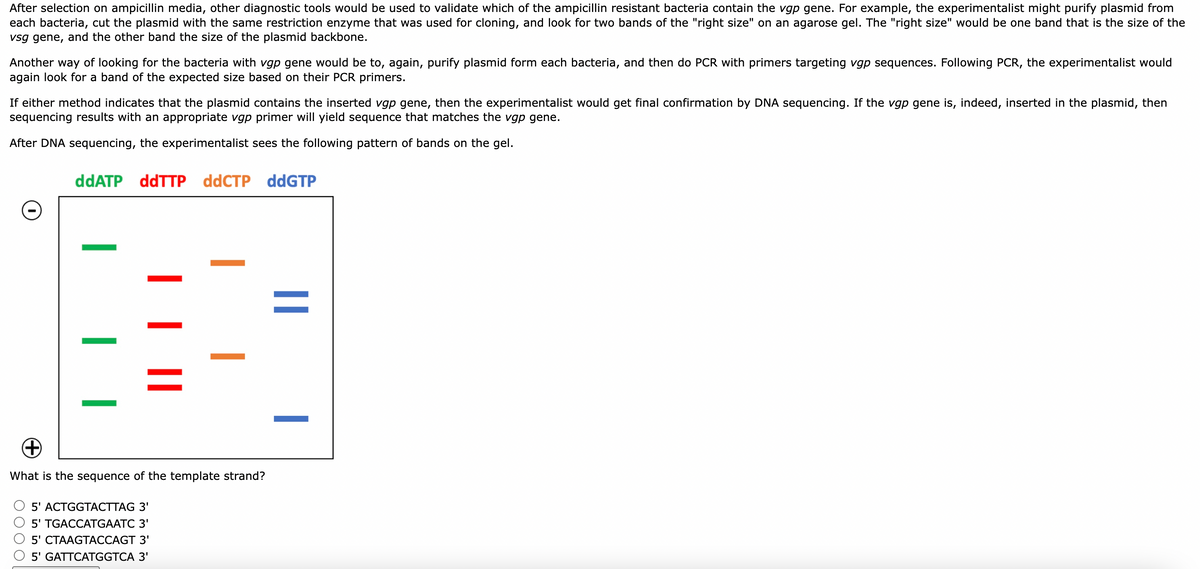After selection on ampicillin media, other diagnostic tools would be used to validate which of the ampicillin resistant bacteria contain the vgp gene. For example, the experimentalist might purify plasmid from each bacteria, cut the plasmid with the same restriction enzyme that was used for cloning, and look for two bands of the "right size" on an agarose gel. The "right size" would be one band that is the size of the vsg gene, and the other band the size of the plasmid backbone. Another way of looking for the bacteria with vgp gene would be to, again, purify plasmid form each bacteria, and then do PCR with primers targeting vgp sequences. Following PCR, the experimentalist would again look for a band of the expected size based on their PCR primers. If either method indicates that the plasmid contains the inserted vgp gene, then the experimentalist would get final confirmation by DNA sequencing. If the vgp gene is, indeed, inserted in the plasmid, then sequencing results with an appropriate vgp primer will yield sequence that matches the vgp gene. After DNA sequencing, the experimentalist sees the following pattern of bands on the gel. ddATP ddTTP ddCTP ddGTP What is the sequence of the template strand? O 5' ACTGGTACTTAG 3" O 5' TGACCATGAATC 3' O 5' CTAAGTACCAGT 3' O 5' GATTCATGGTCA 3'
Molecular Techniques
Molecular techniques are methods employed in molecular biology, genetics, biochemistry, and biophysics to manipulate and analyze nucleic acids (deoxyribonucleic acid (DNA) and ribonucleic acid (RNA)), protein, and lipids. Techniques in molecular biology are employed to investigate the molecular basis for biological activity. These techniques are used to analyze cellular properties, structures, and chemical reactions, with a focus on how certain molecules regulate cellular reactions and growth.
DNA Fingerprinting and Gel Electrophoresis
The genetic makeup of living organisms is shown by a technique known as DNA fingerprinting. The difference is the satellite region of DNA is shown by this process. Alex Jeffreys has invented the process of DNA fingerprinting in 1985. Any biological samples such as blood, hair, saliva, semen can be used for DNA fingerprinting. DNA fingerprinting is also known as DNA profiling or molecular fingerprinting.
Molecular Markers
A known DNA sequence or gene sequence is present on a chromosome, and it is associated with a specific trait or character. It is mainly used as a genetic marker of the molecular marker. The first genetic map was done in a fruit fly, using genes as the first marker. In two categories, molecular markers are classified, classical marker and a DNA marker. A molecular marker is also known as a genetic marker.
DNA Sequencing
The most important feature of DNA (deoxyribonucleic acid) molecules are nucleotide sequences and the identification of genes and their activities. This the reason why scientists have been working to determine the sequences of pieces of DNA covered under the genomic field. The primary objective of the Human Genome Project was to determine the nucleotide sequence of the entire human nuclear genome. DNA sequencing selectively eliminates the introns leading to only exome sequencing that allows proteins coding.
detail explaination
asap

Trending now
This is a popular solution!
Step by step
Solved in 2 steps with 2 images









